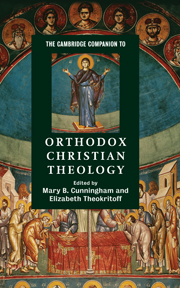Book contents
- Frontmatter
- Who are the Orthodox Christians? A historical introduction
- Part I Doctrine and Tradition
- 1 Scripture and tradition in the Church
- 2 Biblical interpretation in worship
- 3 God in Trinity
- 4 Creator and creation
- 5 The human person as image and likeness of God
- 6 Christ and salvation
- 7 Eschatology
- 8 The Church
- 9 Theology of the icon
- 10 The spiritual way
- Part II Contemporary Orthodox Theology: its Formation and Character
- Glossary
- Bibliography
- Index
- Series list
4 - Creator and creation
from Part I - Doctrine and Tradition
Published online by Cambridge University Press: 28 March 2009
- Frontmatter
- Who are the Orthodox Christians? A historical introduction
- Part I Doctrine and Tradition
- 1 Scripture and tradition in the Church
- 2 Biblical interpretation in worship
- 3 God in Trinity
- 4 Creator and creation
- 5 The human person as image and likeness of God
- 6 Christ and salvation
- 7 Eschatology
- 8 The Church
- 9 Theology of the icon
- 10 The spiritual way
- Part II Contemporary Orthodox Theology: its Formation and Character
- Glossary
- Bibliography
- Index
- Series list
Summary
According to the Christian understanding, the universe is God's creation. God does not simply give form to pre-existent matter, like Plato's demiurge; he invents the material world, bringing it into being out of nothing. This doctrine speaks of both the fragility of creation, in that it has no necessary existence, and its firm foundation in that it exists by God's choice. It is less a theory of origins than a doctrine of relationship between the universe and God. In the striking image attributed to Metropolitan Filaret of Moscow in the nineteenth century, 'All things are balanced upon the creative word of God as on an adamantine bridge: above them is the abyss of the divine infinitude, below them the abyss of their own nothingness.'
This doctrine of creation ex nihilo leaves many questions to be explored. How does God exercise his will in creating and sustaining the world? What is the 'point of contact' between the uncreated and his creation? How can God be present in a universe that is by definition other than himself? What is God's intention for his handiwork, and what role does the human being play in his purposes? We will look first at some patristic approaches to these questions, and then at ways in which patristic insights are developed in modern Orthodox thought.
- Type
- Chapter
- Information
- The Cambridge Companion to Orthodox Christian Theology , pp. 63 - 77Publisher: Cambridge University PressPrint publication year: 2008
- 6
- Cited by



